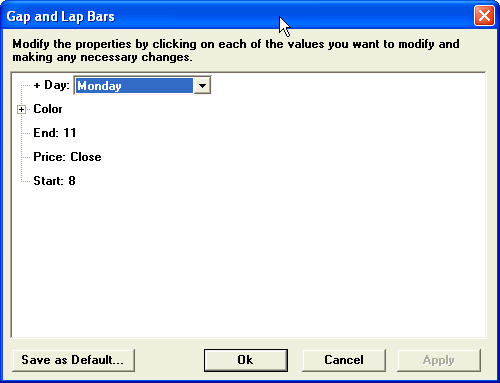|
|
TD Gap illustrates both Gaps and Laps. Gaps occur when either a bar's high fails to intersect the previous bar's low or a bar's low fails to intersect a previous bar's high.
Laps occur when a high or low does intersect the previous bar's high or low, but not the close. Gaps and Laps are represented by a "g" for gap and an "l" for laps.

If the Gap or Lap occurs on a designated day, a "+" is displayed beside the alpha character. For an up gap or lap, capital letters, "G" and "L" respectively, appear once the close of bar 8, 9, 10, or 11, after the gap bar, is greater than all closes of all bars since the Gap or Lap bar.
The reverse logic is used for a down Gap or Lap.
For further information on TDGap, please refer to Thomas R. DeMark, The New Science of Technical Analysis, New York: John Wiley & Sons, 1994, Chapter 8, Gaps.
TD Gap Parameters

This study marks gap and lap bars. The display is simply small labels drawn above or below some bars. (No values are presented in Aspen cursor window by this study.) (NB: "gap bar" for this discussion is different from the usual Aspen meaning of "gap bar.")
An up gap bar has a low price strictly greater than the prior bar's high; a down gap bar has a high price strictly less than the prior bar's low. An up lap bar has a low price strictly greater than the prior bar's close, but not greater than the prior high (so that it is not a gap bar). Similarly, a down lap bar has a high price strictly less than the prior bar's close, but not less than the prior low. Thus every bar is in at most one of these four categories.
Up gaps are marked with a "g" or "G" appearing below the gap bar's low; down gaps are market with "g" or "G" appearing above the gap bar's high. For additional emphasis, different colors are used for up and down labels. Lap bars are market in the same way, but using "l" or "L."
A "+" is added to the label if the bar is a daily bar occurring on a specified day of the week (no "+" signs appear if the timebase is not daily). For example, our research suggests that Monday gaps or laps are pre-meditated and less emotional. Consequently, their appearance conveys more significance than other days of the week.
A gap or lap label is upper case ("G" or "L") if at least one bar occurring from M to N bars (inclusive) after the gap/lap bar has a Price strictly greater than (for up gaps) or less than (for down gaps) the price of all prior bars back to and including the gap/lap bar. The parameters M and N, as well as the tested price, are user-selectable. Lower case is shown if there are enough subsequent bars available to make this determination.
Gap bars (in the Aspen sense) are ignored by this study: a bar is always compared to the prior non-gap bar to determine if it is a gap/lap bar, and Aspen gap bars are ignored in counting forward to determine upper or lower case labeling.
The study command for TDGap is .TDGAP.